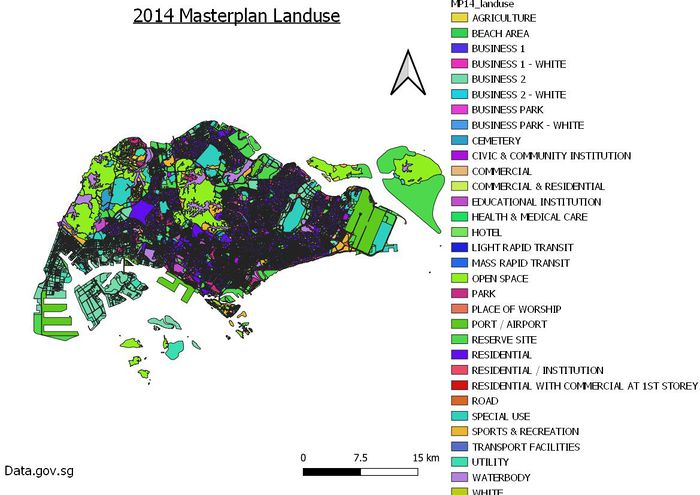SMT201 AY2019-20T1 EX1 Ho Wei Jie Clint
Part 1: Thematic Mapping
Map 1: School Type
- Using school information from data.gov.sg, prepare a thematic map showing the distribution of public education institution by school types such as primary, secondary, etc
The map shows the different type of schools in Singapore, namely – Centralized Institute, Junior College, Mixed Level, Secondary and Primary, where these schools are plotted on top of the masterplan landuse 2014 layer. There are in total of 344 schools. Each different school type is assigned a unique symbol and color to differentiate them. Also, the color of the map (masterplan landuse 2014) was given a neutral color (grey) to make it easier to identify the different colors of the respective type of schools. The source of the layers – schools and masterplan landuse 2014, was taken from data.gov.sg.
Map 2: Road Network System
- Using road GIS data of LTA, prepare a thematic map showing the hierarchy of road network system of Singapore such as expressway, major road, minor road, etc
The map shows the hierarchy of Singapore’s road network system, namely three tiers – Expressway, Major Roads and Minor Roads, where these roads are plotted on top of the masterplan landuse 2014 layer. Each road type is designated a unique color and stroke width to distinguish between the different types of roads. Also, the color of the map (masterplan landuse 2014) was assigned a neutral and brighter color (light yellow) which makes it easier to identify the respective road types through contrast of colors. The source of the layers – roads and masterplan landuse 2014, was taken from data.gov.sg.
Map 3: Master Plan Landuse
- Using master plan landuse GIS data from data.gov.sg, prepare a thematic map showing 2014 Master Plan Landuse.
The map shows a map of the 2014 masterplan landuse from data.gov.sg. The map is categorised into different types of landuse (32 types) where each type of landuse is assigned a unique color, as shown in the legend, which demarcates the landuse area. The use of different colors also makes it easier to identify the different types of landuse.
Part 2: Choropleth Mapping
Using planning subzone GIS data from data.gov.sg and Singapore residents by age group and gender, prepare the following choropleth maps:
- Aged population (+65) in 2010 and 2018.
- Proportional of aged population in 2010 and 2018.
- Percentage change of aged population between 2010 and 2018.
Map 4: Aged population (+65) in 2010 and 2018
The choropleth maps show the aged population (65+) in 2010 and 2018 respectively. The different shades of the same color for each of respective map (Green – 2010 and Red – 2018) represents the distribution of aged population across Singapore. If an area on the map is assigned a darker color shade, it implies that the particular area is more densely populated with an aged population in Singapore. This same meaning is the opposite for a lighter color shade, where a lighter shade implies that the area is less densely populated with an aged population. However, each subzone (MP08 and MP14) is given different datasets (2010 and 2018), as the years increases. In this case, Master Plan subzone 2008 was joined with 2010 data and Master Plan subzone 2014 was joined with 2018 data. The rationale is because the subzone codes between 2008 and 2014 are different as it was updated in 2011 onwards. For example, Master Plan subzone 2008 only has Yio Chu Kang, but Master Plan subzone 2014 was updated with Yio Chu Kang North, East and West. The data is adapted from singstat.gov.sg and data.gov.sg.
Map 5: Proportional of aged population in 2010 and 2018
The choropleth maps show the proportion of aged population in 2010 and 2018 respectively. The different shades of the same color for each of respective map (Orange – 2010 and Blue – 2018) represents the proportion of aged population in Singapore. If an area on the map is assigned a darker color shade, it implies that the particular area has a higher proportion of an aged population in Singapore.
Master Plan subzone 2008 was joined with 2010 data and Master Plan subzone 2014 was joined with 2018 data. This is because the subzone codes between 2008 and 2014 are different as it was updated in 2011 onwards.
In order to determine the proportion of age 65+, new fields (from the attribute table of the subzone) were firstly added through the open field calculator. After creating the relevant fields, the proportion of aged 65+ was derived by dividing the “Total Age 65+” by the “Total of all ages” (TotalAge65+ / sum (age 0-4 + ...... + age 85)). Also, to handle the missing values, the null values were replaced with 0. The data is adapted from singstat.gov.sg and data.gov.sg.
Map 6: Percentage change of aged population between 2010 and 2018
The different colors depicted on the choropleth map shows different amount in terms of percentage change of aged population between 2010 and 2018. Each unique color represents a different amount of percentage change. The “unavailable” (depicted in black) layer is due to the different subzones, between 2014 subzone and 2008 subzone, in terms of their coding due to the update across the years. In this case, there are 13 missing subzones. In order to determine the proportion change between these years, the relevant new fields were created namely – Total of age65+ for each year (2010 and 2018), Total age for each year (2010 and 2018), proportion of each year (2010 and 2018) and percentage change field which was calculated using Percentage change = ((ProportionOfAge65+_2018 - ProportionOfAge65+_2016)/ - ProportionOfAge65+_2016)*100. The missing values were handled by ensuring that the null values/blanks were replaced by 0.






